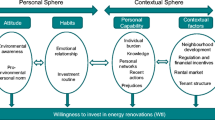Abstract
Article 19 of the Energy Efficiency Directive requires EU member states to address split incentives for energy efficiency between the multiple owners of buildings. But, building governance has been relatively neglected by researchers and policy makers working on Europe’s trajectory to a highly energy-efficient building stock. Taking a socio-legal approach, this paper illustrates the complexities that occur with retrofit of mixed tenure (social and private) apartment blocks and, more broadly, how building governance is a determinant of the costs and outcomes of refurbishment projects. Forty-two percent of Europeans live in apartments and mixed tenure apartment blocks and neighbourhoods have become more prevalent in Europe in recent decades. The paper focuses on a detailed study of a large refurbishment project of five tower blocks by Oxford City Council, involving external wall insulation and other energy efficiency measures. In addition to the Council’s social tenants, these blocks house significant numbers of private owners who have challenged the Council’s attempt to recover from them a share of the refurbishment costs. The experience of the Oxford project raises questions about aspects of property law, allocation of project costs and benefits, and issues of communication, engagement and decision-making. The paper also presents qualitative data gathered from social housing providers through a survey and roundtable meeting to provide an indication of the extent to which these issues are affecting energy efficiency refurbishment projects across England.


Similar content being viewed by others
Data availability
The datasets generated during and/or analysed during the current study are not publicly available as this is ongoing research but, as far as possible within data protection regulations, the anonymised data will be available from the corresponding author on reasonable request following completion of the research.
Notes
We use the term ‘mixed tenure’ in the rest of this paper to refer specifically to a mix of social and private ownership in an apartment block. The term can also be used to refer to different mixes of tenure in buildings (e.g. private short-term rented/privately owner-occupied) and to tenure mix across a neighbourhood.
See Quick v Taff Ely BC (1986) QB 809 (CA).
Assethold Ltd. v Mr. N M Watts (2014) UKUT 537 (LC) at [45]–[49].
The Report to the City Executive Board by the Director of Housing Services also cautions: ‘…there may be further costs associated with delays caused by these works to the overall contract and potential changes to our other blocks following further DCLG testing of other cladding systems’.
And the ability of OCC to increase rents for social tenants is strictly limited by national legislation.
In April 2016, one leaseholder claimed that ‘£60,000 makes for over a half of the typical market value of affected properties (in my case, 65% of the actual purchase price).’ See Oxford City Council 2016b.
Borrowing commercially to finance the costs may not be an option for the flat owners as many lenders will not lend on RTB flats if they are above a certain storey (commonly five) in buildings with concrete construction.
From 2018, the rental of F- and G-banded properties will be restricted on the private rental market in the UK. Further, English environmental health practice and official documents identify most F&G banded homes as constituting a serious health and safety hazard because of the risk of excess cold: see Energy Saving Trust 2010
Wilmott Dixon sold off their energy services division in the course of this project. The new company is known as Fortem.
Statements in this paragraph from Oxford City Council, direct communication, March 2017
Calculation from the Energy Saving Trust online Home Energy Check tool available at http://www.energysavingtrust.org.uk/resources/tools-calculators/home-energy-check
Though the leaseholder quoted in The Guardian claims that their EPC provides an overall estimate for the savings from improving thermal insulation, none of the 13 OTB EPCs reviewed by these researchers identify the savings from installing wall insulation.
Newbolt has also written with TPAS a detailed guide for SHPs to good practice in leaseholder engagement: see Newbolt 2015
Based on the median value for 28 respondents who told us the number of flats in their total stock and the number of flats in private ownership.
References
Assethold Ltd. v Mr. N M Watts (2014). UKUT 537 (LC) at [45]-[49].
BBC Radio 5 Live (2016). Council issues leaseholders with £50,000 bills [Online Audio]. 10 April 2016. Available from: http://www.bbc.co.uk/programmes/p03qg2gt. Accessed 14 Jan 2017.
BM3 Architecture Ltd. (2017). Hockmore Tower, Oxford [online] available at: http://www.bm3.co.uk/projects/hockmore-tower-oxford/. Accessed 13 March 2017.
Bright, S., & Weatherall, D. (2017). Framing and mapping the governance barriers to energy upgrades in flats. Journal of Environmental Law, 29(2), 203–229. https://doi.org/10.1093/jel/eqx017.
Daejan Investments Limited v Benson (2013). UKSC 14; [2013] 1 WLR 854
Directive 2012/27/EU (2012). Of the European Parliament and of the Council of 25 October 2012 on energy efficiency, available at: http://eur-lex.europa.eu/. Accessed 10 May 2018.
Dixon, W. (2015). Willmott Dixon to create better homes in Oxford [online] available at: http://www.willmottdixon.co.uk/news/willmott-dixon-to-create-better-homes-in-oxford. Accessed 16 Jan 2017.
Edozie v Barnet Homes (2015). UKUT 0348.
Energy Saving Trust (2010). F & G banded homes in Great Britain: research into costs of treatment. p. 10. Available at: http://www.inspectyourenergy.co.uk/resources/F$26G+Rated+Home+Report.pdf. Accessed 14 Jan 2017.
English Housing Survey (2013) Housing Stock Data [computer file], UK Data Archive (2015) doi:https://doi.org/10.5255/UKDA-SN-7802-1.
European Commission (2015). Communication from the Commission to the European parliament, the council &c a framework strategy for a resilient energy union with a forward-looking climate change policy, p. 12. Available at: http://eur-lex.europa.eu/. Accessed 10 May 2018.
European Commission (2016). Fact sheet putting energy efficiency first: consuming better, getting cleaner [online] available at: http://europa.eu/rapid/press-release_MEMO-16-3986_en.htm. Accessed 16 Jan 2017.
Eurostat (2018). Housing statistics [online] Available at: http://ec.europa.eu/eurostat/statistics-explained/index.php/Housing_statistics#Type_of_dwelling. Accessed 16 Apr 2018.
Fuerst, F., et al. (2013). Final project report: an investigation of the effect of EPC ratings on house prices. DECC. Available from: https://www.gov.uk/government/publications/an-investigation-of-the-effect-of-epc-ratings-on-house-prices. Accessed 14 Jan 2017.
Gruis, V., Tsenkova, S., & Nieboer, N. (Eds.). (2009). Management of privatised housing: international policies & practice. Chichester: Blackwell Publishing 288 pp, ISBN 978 1 4051 8188 4, ps 281–282.
Head of Oxford City Homes. (2007). Strategy for Tower Blocks, report submitted to the Executive Board of Oxford City council. Oxford: Oxford City Council available at: http://mycouncil.oxford.gov.uk/Data/City%20Executive%20Board/200712030900/Agenda/69831item20.pdf. Accessed 14 Jan 2017.
Housing Act (1985). Available at: https://www.legislation.gov.uk/ukpga/1985/68/contents. Accessed 10 May 2018.
Landlord and Tenant Act (1985). c.7. Available at: http://www.legislation.gov.uk/ukpga/1985/70. Accessed 14 Jan 2017.
LEAF (Low Energy Apartment Futures) (2016). Improving the energy efficiency of apartment blocks LEAF Final Report [online] Edinburgh: LEAF. Available at: http://www.lowenergyapartments.eu. Accessed 10 May 2018.
London Assembly (2012). Highly charged, residential leasehold service charges in London [Online PDF] March 2012, paras 3.14, 3.18. Available at: https://www.london.gov.uk/about-us/london-assembly/london-assembly-publications/service-charges-london. Accessed 14 January 2017.
Lunn, E. (2016). When sky-high repair bills can make right to buy the wrong choice. The Guardian [online], 28 May 2016. Available at: https://www.theguardian.com/money/2016/may/28/right-to-buy-repair-bills-council-tenants . Accessed 14 Jan 2017.
Matschoss, K. et al. (2013) Energy renovations of EU multifamily buildings: do current policies target the real problems? In: Rethink, renew, restart. Proceedings of the eceee 2013 Summer Study. (n 10) p1493.
Newbolt, K. (2015). Leasehold Engagement Guide, TPAS. [online PDF] Available at: https://www.tpas.org.uk/files/1/012195_TPAS_Leasehold_Engagement_Guide_A4.V12.pdf. Accessed 2 Oct 2017.
Newbolt, K. (2017). “Leasehold Engagement” Presentation given at the event Leaseholders and refurbishment: overcoming the legal, practical and policy challenges organised by Future Climate and Oxford University 30 th June 2017. Available at: http://futureclimate.org.uk/leasehold-reform-campaign/event-leaseholders-and-refurbishment-overcoming-the-legal-practical-and-policy-challenges/. Accessed 2nd Oct 2017.
Oliver v Sheffield CC (2015). UKUT 229 (LC).
Oxford City Council (2013). Tower block refurbishment programme Newsletter 2, 17 December 2013 [online PDF] Available at: https://www.oxford.gov.uk/downloads/file/952/tower_block_refurbishment_newsletter_edition_2 Accessed: 10 May 2018.
Oxford City Council (2015). Willmott Dixon proposed as contractor for Oxford tower blocks refurbishment. [Online] Available at: https://www.oxford.gov.uk/news/article/8/willmott_dixon_proposed_as_contractor_for_oxford_tower_blocks_refurbishment. Accessed 14 Jan 2017.
Oxford City Council (2016a). Tower Blocks Refurbishment Project general Q&A [online PDF] January 2016. P.2 Available at: https://www.oxford.gov.uk/downloads/file/2318/tower_block_project_general_questions_and_answers. Accessed 14 Jan 2017.
Oxford City Council (2016b). Public addresses and questions that do not relate to matters for decision—as submitted by the speakers and with written responses, 18 April 2016 Available at: http://mycouncil.oxford.gov.uk/documents/s29439/Council%20180416%20Publicquestionsandaddresses%20for%20briefing%20note.pdf. Accessed 16 Jan 2017.
Oxford City Council (2017). Re-cladding tower blocks report for City Executive Board - Tuesday 15 August 2017 Available at: http://mycouncil.oxford.gov.uk/documents/b14702/Recladding%20tower%20blocks%20report%20Tuesday%2015-Aug2017%2017.00%20City%20Executive%20Board.pdf?T=9. Accessed 2 Oct 2017.
Oxford Mail (2015). The issue: can a £60,000 bill for tower blocks refurbishment ever be affordable?. Oxford Mail [online]. 15 December 2015. Available at: http://www.oxfordmail.co.uk/news/14144863.The_Issue__Can_a___60_000_bill_for_tower_blocks_refurbishment_ever_be_affordable_/. Accessed 14 Jan 2017.
Quick v Taff Ely BC (1986). QB 809.
Sheffield City Council v Oliver (2008). LRX/146/2007.
Sheffield City Council v Oliver (2017). EWCA Civ 225
Somerville, H. (2016a). Leaseholders in Oxford’s towers say new flat interiors “appalling” after Oxford City Council’s 20m refurb. Oxford Mail [online], 9 September 2016. Available at: http://www.oxfordmail.co.uk/news/14733276.More_fuel_for_tribunal_after_tower_interior_works_called__quot_appalling_quot_/. Accessed 14 Jan 2017.
Somerville, H. (2016b). Residents in Oxford’s five tower blocks warned over bankruptcy by OTLA as £50k repair bill row goes on. Oxford Mail [online], 9 February 2016. Available at: http://www.oxfordmail.co.uk/news/14261925.Tower_block_residents_fear_bankruptcy_as_row_over___50k_repair_bills_continues/?ref=arc. Accessed 14 Jan 2017.
Waaler v London Borough of Hounslow (2015). UKUT 17.
Weatherall, D. (2016). Taking action to improve energy refurbishment of flats [online] Association for the Conservation of Energy. Available at: http://www.ukace.org/2016/02/taking-action-to-improve-energy-refurbishment-of-flats/. Accessed 14 Jan 2017.
Weatherall, D., McCarthy, F., & Bright, S. (2017). Property law as a barrier to energy upgrades in multi-owned properties: insights from a study of England and Scotland. Energy Efficiency. https://doi.org/10.1007/s12053-017-9540-5.
Funding
Financial support for the project is provided by the Oxford University John Fell Fund.
David Weatherall’s work on this project is supported by an Oxford University Knowledge Exchange Fellowship.
Author information
Authors and Affiliations
Corresponding author
Ethics declarations
The research underlying this paper has received ethics approval from CUREC, University of Oxford, ref no. R46808/RE001.
Conflict of interest
The authors declare that they have no conflict of interest.
Rights and permissions
About this article
Cite this article
Bright, S., Weatherall, D. & Willis, R. Exploring the complexities of energy retrofit in mixed tenure social housing: a case study from England, UK. Energy Efficiency 12, 157–174 (2019). https://doi.org/10.1007/s12053-018-9676-y
Received:
Accepted:
Published:
Issue Date:
DOI: https://doi.org/10.1007/s12053-018-9676-y




